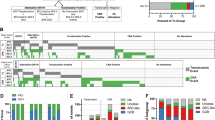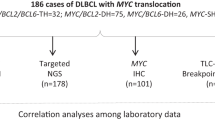Abstract
The chromosomal translocation t(8;14) is the hallmark of Burkitt's-lymphoma (BL) and fuses the proto-oncogene c-MYC to the IGH locus. We analyzed the genomic structure of MYC/IGH fusions derived from a large series of 78 patients with t(8;14) and asked (i) whether distinct breakpoint clusters exist within the MYC gene and (ii) whether any pairwise association between particular IGH and MYC breakpoints exist. Identification of such associations will help elucidate the etiology of the breaks on the MYC locus. Scan statistic analyses revealed two distinct, but large clusters within c-MYC containing 60/78 (77%) of the breakpoints. Clusters 1 and 2 were 560 and 779 bp in length within a 4555 bp breakpoint cluster region. Breaks within IGH switch μ and joining region did not differ with respect to their corresponding MYC breakpoints. However, there was a highly significant correlation between breakpoints 5′ of MYC cluster 1 and fusions to IGH switch γ region and breakpoints downstream of MYC cluster 2 and fusions to IGH switch α region (χ2-test: P<0.005). Chromatin changes governing choice of IGH-Fc region recombination may parallel changes in the MYC gene 5′ region chromatin leading to some degree of coordinated ontological specificity in breakpoint location.
This is a preview of subscription content, access via your institution
Access options
Subscribe to this journal
Receive 12 print issues and online access
$259.00 per year
only $21.58 per issue
Buy this article
- Purchase on Springer Link
- Instant access to full article PDF
Prices may be subject to local taxes which are calculated during checkout







Similar content being viewed by others
References
Dudley DD, Chaudhuri J, Bassing CH, Alt FW . Mechanism and Control of V(D)J Recombination versus Class Switch Recombination: Similarities and Differences. Adv Immunol 2005; 86: 43–112.
Jung D, Alt FW . Unraveling V(D)J recombination; insights into gene regulation. Cell 2004; 116: 299–311.
Fugmann SD, Lee AI, Shockett PE, Villey IJ, Schatz DG . The RAG proteins and V(D)J recombination: complexes, ends, and transposition. Annu Rev Immunol 2000; 18: 495–527.
Kuppers R . Mechanisms of B-cell lymphoma pathogenesis. Nat Rev Cancer 2005; 5: 251–262.
Korsmeyer SJ . Chromosomal translocations in lymphoid malignancies reveal novel proto-oncogenes. Annu Rev Immunol 1992; 10: 785–807.
Dalla-Favera R, Martinotti S, Gallo RC, Erikson J, Croce CM . Translocation and rearrangements of the c-myc oncogene locus in human undifferentiated B-cell lymphomas. Science 1983; 219: 963–967.
Roth DB . Restraining the V(D)J recombinase. Nat Rev Immunol 2003; 3: 656–666.
Marculescu R, Le T, Simon P, Jaeger U, Nadel B . V(D)J-mediated translocations in lymphoid neoplasms: a functional assessment of genomic instability by cryptic sites. J Exp Med 2002; 195: 85–98.
Kuppers R, Dalla-Favera R . Mechanisms of chromosomal translocations in B cell lymphomas. Oncogene 2001; 20: 5580–5594.
Goossens T, Klein U, Kuppers R . Frequent occurrence of deletions and duplications during somatic hypermutation: implications for oncogene translocations and heavy chain disease. Proc Natl Acad Sci USA 1998; 95: 2463–2468.
Vanasse GJ, Halbrook J, Thomas S, Burgess A, Hoekstra MF, Disteche CM et al. Genetic pathway to recurrent chromosome translocations in murine lymphoma involves V(D)J recombinase. J Clin Invest 1999; 103: 1669–1675.
Lee GS, Neiditch MB, Salus SS, Roth DB . RAG proteins shepherd double-strand breaks to a specific pathway, suppressing error-prone repair, but RAG nicking initiates homologous recombination. Cell 2004; 117: 171–184.
Raghavan SC, Swanson PC, Wu X, Hsieh CL, Lieber MR . A non-B-DNA structure at the Bcl-2 major breakpoint region is cleaved by the RAG complex. Nature 2004; 428: 88–93.
Raghavan SC, Houston S, Hegde BG, Langen R, Haworth IS, Lieber MR . Stability and strand asymmetry in the non-B DNA structure at the bcl-2 major breakpoint region. J Biol Chem 2004; 279: 46213–46225.
Raghavan SC, Hsieh CL, Lieber MR . Both V(D)J coding ends but neither signal end can recombine at the bcl-2 major breakpoint region, and the rejoining is ligase IV dependent. Mol Cell Biol 2005; 25: 6475–6484.
Raghavan SC, Swanson PC, Ma Y, Lieber MR . Double-strand break formation by the RAG complex at the bcl-2 major breakpoint region and at other non-B DNA structures in vitro. Mol Cell Biol 2005; 25: 5904–5919.
Bacolla A, Jaworski A, Larson JE, Jakupciak JP, Chuzhanova N, Abeysinghe SS et al. Breakpoints of gross deletions coincide with non-B DNA conformations. Proc Natl Acad Sci USA 2004; 101: 14162–14167.
Ramiro AR, Jankovic M, Eisenreich T, Difilippantonio S, Chen-Kiang S, Muramatsu M et al. AID is required for c-myc/IgH chromosome translocations in vivo. Cell 2004; 118: 431–438.
Duquette ML, Pham P, Goodman MF, Maizels N . AID binds to transcription-induced structures in c-MYC that map to regions associated with translocation and hypermutation. Oncogene 2005; 24: 5791–5798.
Zech L, Haglund U, Nilsson K, Klein G . Characteristic chromosomal abnormalities in biopsies and lymphoid cell lines from patients with Burkitt and non-Burkitt lymphomas. Int J Cancer 1976; 17: 47–56.
Mitelman F, Andersson-Anvret M, Brandt L, Catovsky D, Klein G, Manolov G et al. Reciprocal 8;14 translocation in EBV-negative B-cell acute lymphocytic leukemia with burkitt-type cells. Int J Cancer 1979; 24: 27–33.
Busch K, Borkhardt A, Wossmann W, Reiter A, Harbott J . Combined polymerase chain reaction methods to detect c-myc/IgH rearrangement in childhood Burkitt s lymphoma for minimal residual disease analysis. Haematologica 2004; 89: 818–825.
Wilda M, Busch K, Klose I, Keller T, Woessmann W, Kreuder J et al. Level of MYC overexpression in pediatric Burkitt's lymphoma is strongly dependent on genomic breakpoint location within the MYC locus. Genes Chromosome Cancer 2004; 41: 178–182.
Segal GH, Wiemels J . Clustering of Translocation Breakpoints. J Am Stat Assoc 2002; 97: 66–76.
Kulldorff M . Software for the spatial and space-time scan statistics. National Cancer Institute, Bethesda, MD, 2002.
Lawrence CE, Altschul SF, Boguski MS, Liu JS, Neuwald AF, Wootton JC . Detecting subtle sequence signals: a Gibbs sampling strategy for multiple alignment. Science 1993; 262: 208–214.
Bailey TL, Elkan C . Fitting a mixture model by expectation maximization to discover motifs in biopolymers. Proc Int Conf Intell Syst Mol Biol 1994; 2: 28–36.
Yamaguchi M, Hendrickson EA, DePamphilis ML . DNA primase-DNA polymerase alpha from simian cells: sequence specificity of initiation sites on simian virus 40 DNA. Mol Cell Biol 1985; 5: 1170–1183.
Hefferin ML, Tomkinson AE . Mechanism of DNA double-strand break repair by non-homologous end joining. DNA Repair (Amst) 2005; 4: 639–648.
Murphy SB . Classification, staging and end results of treatment of childhood non-Hodgkin's lymphomas: dissimilarities from lymphomas in adults. Semin Oncol 1980; 7: 332–339.
Posey JE, Brandt VL, Roth DB . Paradigm switching in the germinal center. Nat Immunol 2004; 5: 476–477.
Mills KD, Ferguson DO, Alt FW . The role of DNA breaks in genomic instability and tumorigenesis. Immunol Rev 2003; 194: 77–95.
Ma L, Wortis HH, Kenter AL . Two new isotype-specific switching activities detected for Ig class switching. J Immunol 2002; 168: 2835–2846.
Shanmugam A, Shi MJ, Yauch L, Stavnezer J, Kenter AL . Evidence for class-specific factors in immunoglobulin isotype switching. J Exp Med 2000; 191: 1365–1380.
Zelazowski P, Carrasco D, Rosas FR, Moorman MA, Bravo R, Snapper CM . B cells genetically deficient in the c-Rel transactivation domain have selective defects in germline CH transcription and Ig class switching. J Immunol 1997; 159: 3133–3139.
Wuerffel RA, Ma L, Kenter AL . NF-kappa B p50-dependent in vivo footprints at Ig S gamma 3 DNA are correlated with mu-->gamma 3 switch recombination. J Immunol 2001; 166: 4552–4559.
Snapper CM, Zelazowski P, Rosas FR, Kehry MR, Tian M, Baltimore D et al. B cells from p50/NF-kappa B knockout mice have selective defects in proliferation, differentiation, germ-line CH transcription, and Ig class switching. J Immunol 1996; 156: 183–191.
Manis JP, Morales JC, Xia Z, Kutok JL, Alt FW, Carpenter PB . 53BP1 links DNA damage-response pathways to immunoglobulin heavy chain class-switch recombination. Nat Immunol 2004; 5: 481–487.
Bassing CH, Alt FW . H2AX may function as an anchor to hold broken chromosomal DNA ends in close proximity. Cell Cycle 2004; 3: 149–153.
Bassing CH, Alt FW . Molecular biology: case of mistaken identity. Nature 2004; 428: 29–31.
Bassing CH, Suh H, Ferguson DO, Chua KF, Manis J, Eckersdorff M et al. Histone H2AX: a dosage-dependent suppressor of oncogenic translocations and tumors. Cell 2003; 114: 359–370.
Yagil G . Paranemic structures of DNA and their role in DNA unwinding. Crit Rev Biochem Mol Biol 1991; 26: 475–559.
Htun H, Dahlberg JE . Single strands, triple strands, and kinks in H-DNA. Science 1988; 241: 1791–1796.
Lee GS, Neiditch MB, Sinden RR, Roth DB . Targeted transposition by the V(D)J recombinase. Mol Cell Biol 2002; 22: 2068–2077.
Honjo T, Kinoshita K, Muramatsu M . Molecular mechanism of class switch recombination: linkage with somatic hypermutation. Annu Rev Immunol 2002; 20: 165–196.
Ramiro AR, Jankovic M, Callen E, Difilippantonio S, Chen HT, McBride KM et al. Role of genomic instability and p53 in AID-induced c-myc-Igh translocations. Nature 2006; 440: 105–109.
Acknowledgements
We are indebted to the technical staff of the Department of Pediatric Hematology and Oncology, Giessen, especially to Jutta Schieferstein and Franziska Müller for excellent technical assistance. We thank Martin Zimmermann (Department of General pediatrics, Medical School, Kiel, Germany) for statistical analysis of the clinical features. The study was funded in part by grants from the network of competence ‘Pediatric Oncology’ of the Bundesministerium für Bildung und Forschung (BMBF) No. 01GI9963 and the Forschungshilfe Station Peiper. AB and UF were supported by a Grant from the German Cancer Association, the Else-Kröner-Fresenius-Foundation and the Research Foundation of the University of Munich, Germany. JW is a Scholar of the Leukemia and Lymphoma Society of America.
Author information
Authors and Affiliations
Corresponding author
Additional information
Supplementary Information accompanies the paper on the Leukemia website (http://www.nature.com/leu)
Rights and permissions
About this article
Cite this article
Busch, K., Keller, T., Fuchs, U. et al. Identification of two distinct MYC breakpoint clusters and their association with various IGH breakpoint regions in the t(8;14) translocations in sporadic Burkitt-lymphoma. Leukemia 21, 1739–1751 (2007). https://doi.org/10.1038/sj.leu.2404753
Received:
Revised:
Accepted:
Published:
Issue Date:
DOI: https://doi.org/10.1038/sj.leu.2404753
Keywords
This article is cited by
-
Characterization of IG-MYC-breakpoints and their application for quantitative minimal disease monitoring in high-risk pediatric Burkitt-lymphoma and -leukemia
Leukemia (2022)
-
Recurrent 8q24 rearrangement in blastic plasmacytoid dendritic cell neoplasm: association with immunoblastoid cytomorphology, MYC expression, and drug response
Leukemia (2018)
-
Arsenic trioxide inhibits EBV reactivation and promotes cell death in EBV-positive lymphoma cells
Virology Journal (2017)
-
Synergistic action of 5Z-7-oxozeaenol and bortezomib in inducing apoptosis of Burkitt lymphoma cell line Daudi
Tumor Biology (2016)
-
Atypical rearrangement involving 3′-IGH@ and a breakpoint at least 400 Kb upstream of an intact MYC in a CLL patient with an apparently balanced t(8;14)(q24.1;q32) and negative MYC expression
Molecular Cytogenetics (2013)



